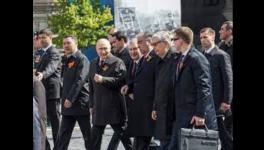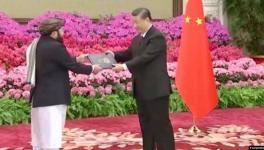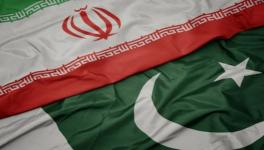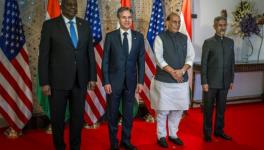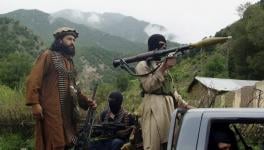What Does Trump's New Afghan Strategy Mean for South Asia?
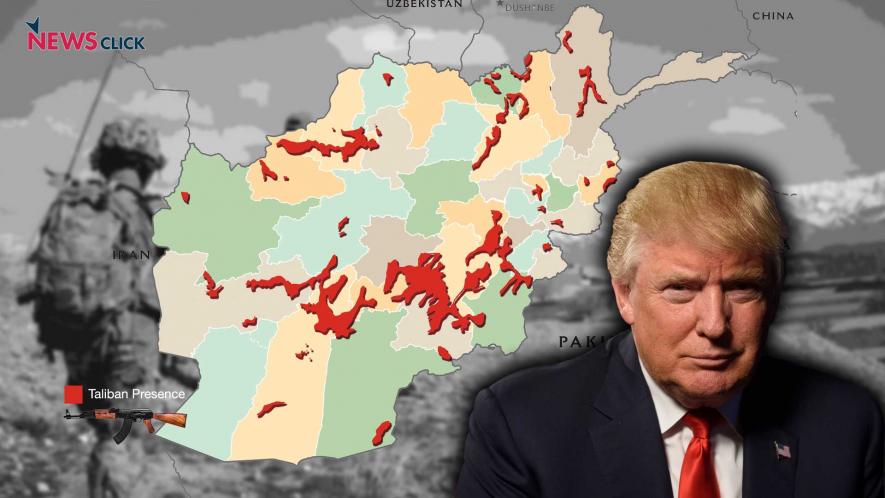
Newsclick Image by Nitesh Kumar
The US President Donald Trump unveiled a new military strategy for the ongoing war in Afghanistan. Much to everyone’s surprise, the POTUS asserted that American forces are not pulling out of the area and was instead sending additional troops to back the Kabul regime in its fight against the Taliban and emerging IS in the region.
Trump noted that the US sought an “honourable and enduring outcome” from the 17-year-old war in the war-ravaged nation; not just to win over Taliban but, to prove that the US is not letting an empire slip into the graveyard that Afghanistan is known to be.
Frustrated with its regional partner, Trump trained his guns on its long-time ally Pakistan, in his latest address on US strategy in Afghanistan earlier this week. The US president appreciated Pak’s regional arch-rival India and urged the latter to increase its contribution and assistance in Afghanistan.
This calculated move – on the surface - meant huge embarrassment for Pakistan and a long sought push for India to increase its influence in the region. But, deep down Trump’s reversal of position from his previous will to withdraw from Afghan war is likely to pave way for realignments in the region and a further grind for the US in Afghanistan.
A safe haven
After the Soviet invasion of Afghanistan in 1979, the country became a common ground for Muslim insurgents across the world. The call of Jihad was responded to by people from across the Muslim world. Apart from Afghan’s own Mujahideen backed by the US, radicalized youth, disillusioned with their respective governments in the Arab world constituted the insurgents fighting the Soviets. They were armed by the US and its allies and Pakistan became a key facilitator of supplying arms and ammunitions to the insurgents.
Towards the end of the war, as Soviets left and the US abandoned the country, Afghanistan became a country of warlords wielding influence in their respective areas. Marred with crime, civil war and chaos, Pakistan continued to support the newly formed Afghan government and at the same time invested in an emerging phenomenon– they called the Taliban, who went on to form the government ultimately.
Afghanistan under Taliban government recognized first by only Saudi Arabia, UAE and Pakistan, became a tactical ally for most insurgent outfits. For Pakistan supporting insurgencies had become an easier way to achieve its interests and thus began to increase the program until Al-Qaeda’s attack on US soil changed the whole scenario.
By then, Pakistan and Afghanistan both had become the home turf for disillusioned youth from the Muslim world and its militant leaders like Osama Bin Laden, Ayman al Zawahiri and Abu Musab al Zarqawi had sown the seeds of global expansionism through insurgency in the minds of young protégés. The Taliban leaders, however, remained mostly wary of Arab fighters and their plans.
In 2004, former President George W Bush referred to Pakistan as an ally in the War on Terror following which the Pakistan had to fight on multiple fronts. The war in Afghanistan led to Al Qaeda and other insurgent groups building pressure on Pakistan through series of attacks and bomb blasts. Pakistan continues to suffer because of its continued support to non-state actors including those in Kashmir, where most of the insurgency continues to be sustained by them. A directive to contain the “safe havens” would, however, mean further crackdown towards the western frontier.
Even today, as Mr Trump said, there are as many as 20 US designated foreign terrorist organizations active in Afghanistan and Pakistan despite the military action. The war has spread and not just the whole of West Asia but Pakistan is trying hard to reverse its decision on supporting actors that led to the creation of outfits like ISIS and TTP which ultimately turned against the country where they were born. The US now appears too late in reprimanding Pakistan.
The disappointment of Afghan Taliban over US intervention not going to end will be shared by other major insurgency outfits like Al-Qaeda and the Islamic State and also by insurgents in Pakistan like Tehreek-e-Taliban (TTP) and its affiliated groups. This, however, throws an opportunity for Pakistan to deal with its internal problems and redefine itself policies while it moves closer to its “all weather friend” China and to Russia as well.
Regional impact
Both China and Russia are looking for a stronger regional balance in South Asia to thwart the US influence mostly displayed by Pakistan. While Pakistan shared deep economic, military and defence partnership with the US hitherto, India has also emerged over the years as a “key economic and security partner”, pointed out by Mr Trump during his address.
The salvo against Pakistan was expected as the country had already started to loosen its ties with the US and move closer to China which making huge investments worth billions of dollars on a key transport route China-Pakistan-Economic-Corridor (CPEC). After Pakistan was heckled by Mr Trump, China rose in Pak’s defence stating Pakistan’s role in Afghanistan must be “valued” and its sovereignty “respected”. China also expressed willingness to coordinate with the US for stability in Afghanistan.
The US throwing its weight behind India also comes at a time when India is being bullied continuously by China in at least two frontiers areas in the state of Jammu and Kashmir and in Bhutan, where both the states divulged in brinkmanship.
Both India and Pakistan have been increasingly competing to increase their influence in Afghanistan to aid their own rivalry. The Trump’s latest remarks give much of an opportunity for India to do so but it also brings forth bigger challenges for the country – especially when it already faces hostilities in several frontier areas.
Taliban controls one-third of the territory in Afghanistan currently and the reins are slipping into its folds slowly. In the backdrop of Taliban’s current prowess, the lack of further advance in terms of territory appeared a tactical move by Taliban as it awaited US withdrawal. What remains to be seen is how Taliban will now reshape its military response to its enemy's renewed strategy in Afghanistan.
Disclaimer: The views expressed here are the author's personal views, and do not necessarily represent the views of Newsclick.
Get the latest reports & analysis with people's perspective on Protests, movements & deep analytical videos, discussions of the current affairs in your Telegram app. Subscribe to NewsClick's Telegram channel & get Real-Time updates on stories, as they get published on our website.









